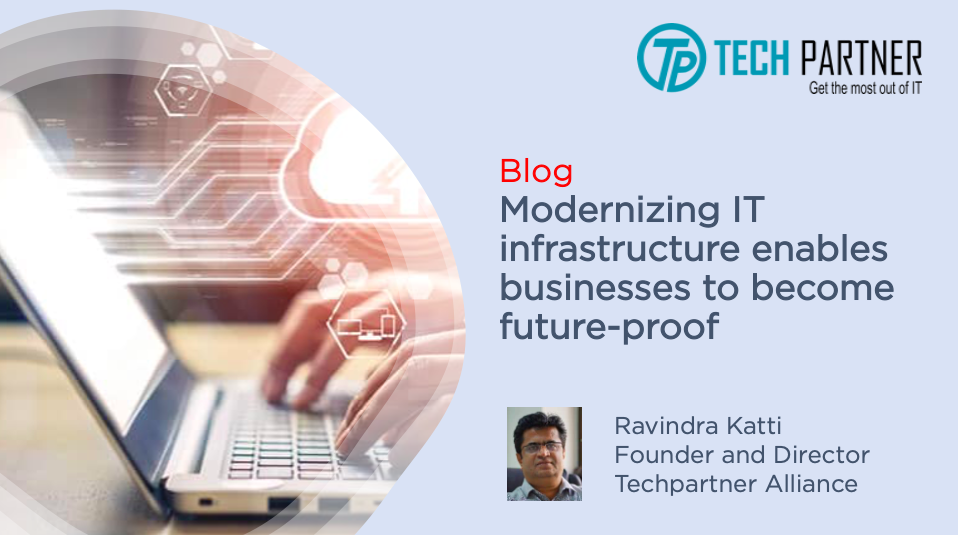Modernizing IT infrastructure enables businesses to become future-proof - Ravindra Katti - Founder and Director - Techpartner Alliance

Considered
to be roadblocks to digital transformation, legacy systems and infrastructure
have to soon be replaced if organizations have to stay ahead of the curve.
These systems operate in silos harming productivity and are not compatible with
other data systems. Being unreliable and
inefficient they increase the downtime and maintaining them is expensive
too. Delivering poor customer
experience, these obsolete systems pose many risks and challenges and are
unsustainable.
On the other hand, it makes good business sense for organizations to modernize their infrastructure to benefit from the several advantages it offers. Reliability, cost-effectiveness, faster go-to-market, scalability, and flexibility are only a few rewards the modern IT environment extends. Furthermore, this advanced infrastructure is highly secure and supports innovation which drives the creation of differentiators for the organization. Businesses have this sound option of modernizing the infrastructure and applications thereby empowering teams to deliver better performance.
There are several factors to be taken into consideration when it comes to modernizing the IT Infrastructure. With organizations modernizing their IT infrastructure, the existing application stacks are transformed.
Multi-cloud
strategy
Cloud services help in optimizing those applications that are unique to the respective services provider. The portfolio of cloud services, the tools to enable DevOps and other advantages differ from one cloud service provider to another. To manage the various cloud providers and run different workloads on specific clouds as the business demands, is by establishing a multi-cloud infrastructure. This enhances efficiency across all environments. IT leaders are choosing hybrid cloud to accelerate the organization’s IT infrastructure modernization efforts. This approach delivers more flexibility and intensifies security measures.
Hybrid
approach
Hybrid cloud integrates across on-premises infrastructure, and private and public cloud environments. Being a seamlessly connected system, it enables orchestration and portability across the environments. The traditional hybrid cloud infrastructure only focused on transforming select aspects of the on-prem to private cloud to be later connected to the public cloud. In contrast, the modern hybrid cloud architecture improves app portability across all cloud environments. Automating the deployments of the workloads to the most suitable environment is another significant aspect of the hybrid approach. Organizations are now aware of the long-term advantages of hybrid cloud adoption including cost efficiency. During the expansion of IT capabilities, investments in buying, installing, and maintaining additional servers are eliminated. It also delivers edge computing capabilities increasing the speed of operations and ensuring critical services are close to end-users.
Machine
learning (ML) and Artificial Intelligence (AI)
Intelligence is not present in the IT infrastructure for learning and observing the correlation between various IT elements. Data trends and insights for making the right decisions are not possible without the introduction of AI-based IT infrastructure which leverages Machine Learning, Big Data and Analytics. Advanced Machine Learning (ML) algorithms help in effectively identifying the outliers and prevent potential disruptions of the IT infrastructure.
AIOps
(Artificial Intelligence for IT Operations)
IT Automation drives efficiency and optimization in today’s IT environment which in turn is very dynamic. Digital Transformation efforts are accelerated in the process. AI for Infrastructure does automate IT operations by leveraging Machine Learning where the IT environment is modernized, optimized, and managed. AIOps accelerates IT operations with its key aspects of automating behavior prediction, anomaly detection, real-time analysis, and enabling data-driven decision-making. With AIOps, the high complexity and quantity of data generated by the IT environment are reduced considerably. It also eliminates silos by correlating information across multiple platforms.
Containerization for
implementing DevOps:
DevOps is a practice of bringing together the development team and the operations team to collaborate and work. These teams are increasingly leveraging containerization technology which is an answer to the challenges of running Virtual Machines (VMs). Containerization is the placement of a software component along with its libraries, system tools, dependencies as well as configuration into an isolated container. Unlike the VMs that focuses on the hardware, containerization enables developers to build, test and deploy pipelines at the operating system level. Containers are flexible and easy to deploy and manage thus the DevOps teams are empowered with agility.
Monitoring,
Logging, and Auto-remediation
For
years IT teams were monitoring different parts of the infrastructure which led
to silos. This was not scalable
too. With containers, there has been a
dramatic improvement in efficiency but it has monitoring challenges. Only an IT infrastructure monitoring strategy
can support IT Operations (ITOps) teams to avoid struggling with the
complexity. A robust infrastructure
monitoring strategy is AI/ML-enabled along with a single platform covering
centralized and observable data.
Automated remediation of any incident can help the team members to address issues at a faster pace and covers alerting mechanisms and logging to completely automated remediation. The benefits of this process include enhanced efficiency and saving time for manpower to perform higher-end tasks, improved security, and continuous compliance logging.
Cybersecurity
and Data protection
Protection of the IT Infrastructure ensures relevant measures are in place to safeguard the IT environment and the assets in an enterprise. With the rise in the deployment of digital technologies, the threat landscape is also expanding at a much faster pace than before. IT infrastructures across organizations of all sizes are under constant attacks, both externally and internally. Data breaches can halt day-to-day operations, increase customer churn, lead to higher revenue losses, and can even harm the brand’s reputation. Building an effective cybersecurity strategy is key, which is a smart approach to comprehensive security. Elements such as monitoring solutions, firewalls, protection against ransomware, Distributed Denial of Services (DDoS) protection, Endpoint Protection, and Response (EDR), and Extended Protection and Response (XDR) among others should be included in the protection against cyberattacks.
CIOs
across industry verticals are today working with business leaders to leverage
digital technologies to accelerate business performance. This transformation and achievement are only
made possible with IT infrastructure modernization.



